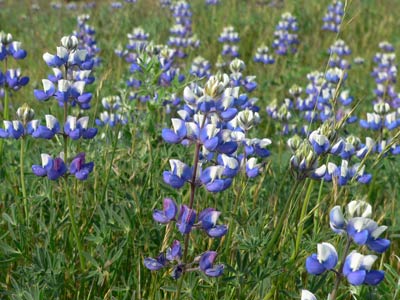
Also known as field lupine, dwarf lupine, ocean-blue lupine and Douglas’ annual lupine, this native of western US grows on slopes and open or disturbed areas of California, Nevada, and the Steens Mountains in eastern Oregon. It is a member of the legume family, Fabaceae, that also includes beans, mimosa, and black locust. The plant grows 6-24″ tall and has palmately compound leaves with 5-7 narrow leaflets that are hairy and up to 1.5″ long. In spring, 1.6 to 16″ long racemes of whorled flowers appear that are attractive to hummingbirds, butterflies, and bees, and are good in the vase. The pea-like flowers are fragrant and have blue to lavender keel, wings and banner with white or yellow spot. Tolerant of drought and lean soil, the plants are valued for revegetation projects in difficult sites and used in containers, wildlife, bee, butterfly, hummingbird, bird, pollinator, and rock gardens. Three subspecies are accepted. The genus name, Lupinus, is derived from the Latin word lupus meaning wolf, and refers to the false belief the plants destroyed the soil. The specific epithet, nanus, is the Latin word meaning dwarf, and refers to the plants diminutive size.
Type: Annual
Bloom: Racemes of whorled pea-like blue to lavender flowers in spring
Size: 6-24″ H x 12′ W
Light: Full sun
Soil: Lean, dry, well-drained
Hardiness: Not relevant
Care: Low maintenance
Pests and Diseases: Generally healthy but susceptible to damage by aphids, anthracnose, mosaic virus.
Propagation: Seed in late fall or winter ( often self-seeds)
Companion Plants: California poppy, California goldfields, mariposa lily
Outstanding Selections: None
Photo Credit: Wikipedia